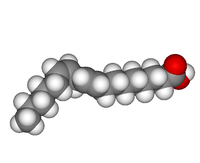
Photo from wikipedia
Studies of the bioavailability of proanthocyanidins usually consider them independently of other dietary constituents, while there is a tendency in the field of functional foods towards the combination of different… Click to show full abstract
Studies of the bioavailability of proanthocyanidins usually consider them independently of other dietary constituents, while there is a tendency in the field of functional foods towards the combination of different bioactive compounds in a single product. This study examined the long-term effects of ω-3 polyunsaturated fatty acids of marine origin on the metabolic fate of grape proanthocyanidins. For this, female adult Wistar-Kyoto rats were fed (18weeks) with a standard diet supplemented or not with eicosapentaenoic acid/docosahexaenoic acid (1:1, 16.6g/kg feed), proanthocyanidin-rich grape seed extract (0.8g/kg feed) or both. A total of 39 microbial-derived metabolites and 16 conjugated metabolites were detected by HPLC-MS/MS either in urine or in the aqueous fraction of feces. An unexpected significant increase in many proanthocyanidin metabolites in urine and feces was observed in the group supplemented with ω-3 polyunsaturated fatty acids group as compared to the animals fed a standard diet, which contains a small amount of polyphenols. However, proanthocyanidin metabolites in rats given ω-3 polyunsaturated fatty acids and grape seed extract did not significantly differ from those in the group supplemented only with grape seed extract. It was concluded that ω-3 polyunsaturated fatty acids collaborate in the metabolism of polyphenols when present at low doses in the feed matrix, while the capacity of ω-3 polyunsaturated fatty acids to induce microbiota transformations when proanthocyanidins are present at high doses is not relevant compared to that of polyphenols themselves.
Journal Title: Food research international
Year Published: 2017
Link to full text (if available)
Share on Social Media: Sign Up to like & get
recommendations!